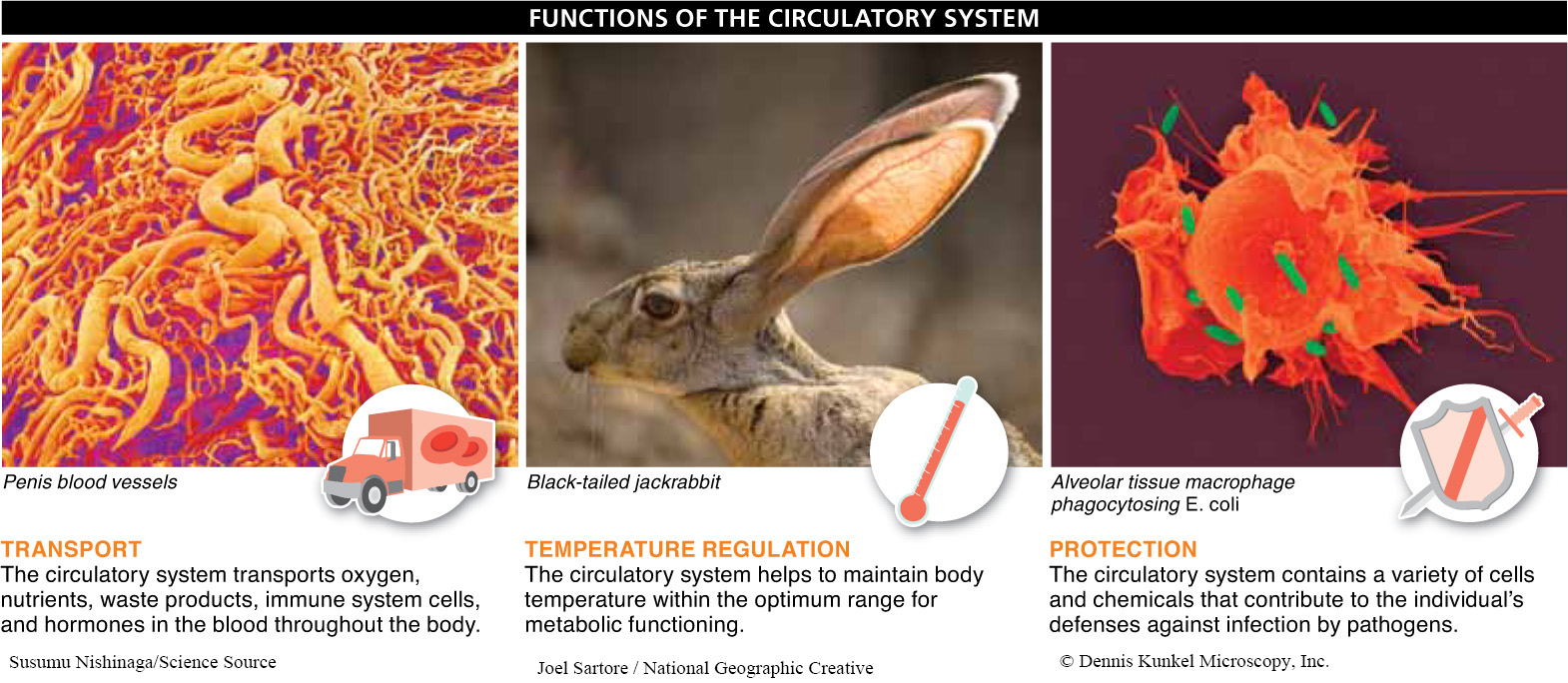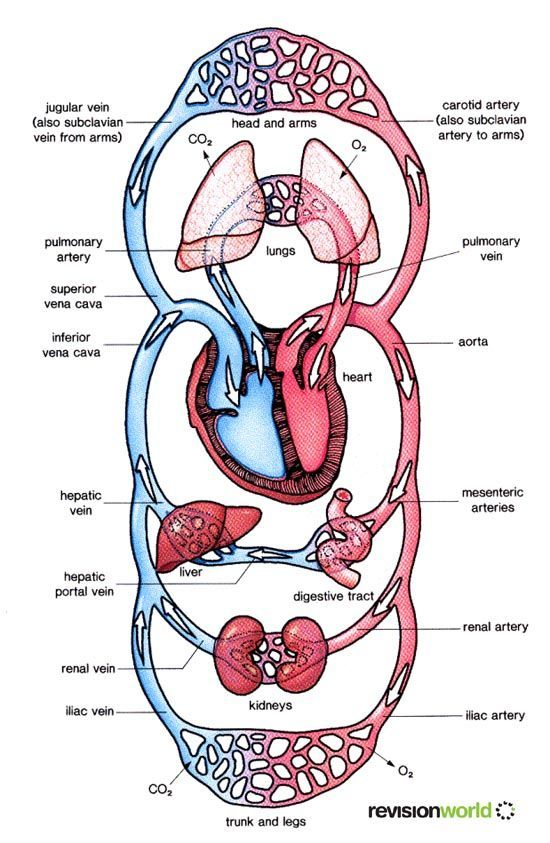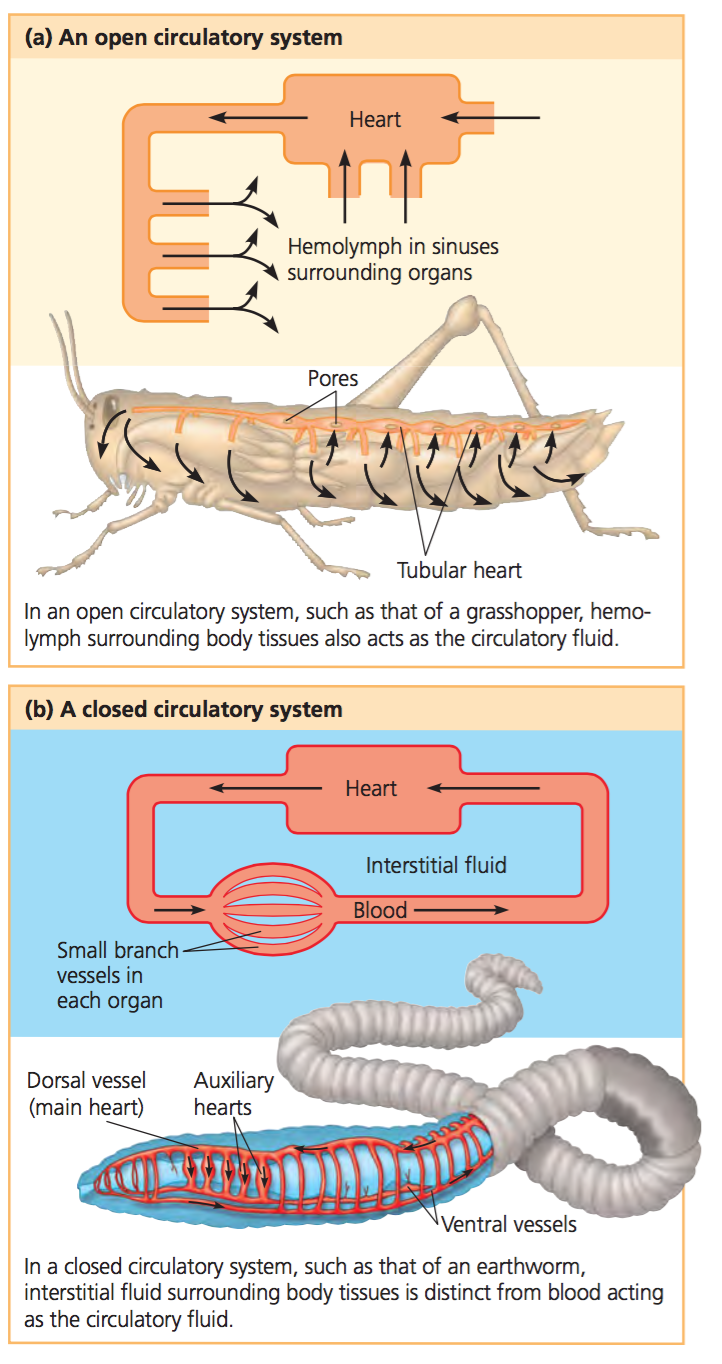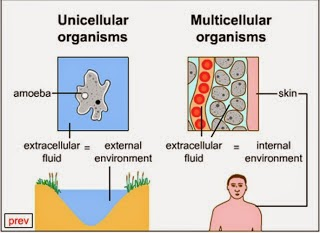8.01 Transport Systems in Animals
Definition:
- The transport system in animals is a biological mechanism that delivers oxygen, nutrients, hormones, and waste products to and from cells, ensuring efficient energy production and homeostasis.
Why Transport Systems Are Needed in Animals
- Support High Activity Levels
- Increased Mobility: Enables animals to move actively to find food, escape predators, and perform other essential behaviors.
- Energy for Movement: Supplies all cells with nutrients needed for tasks such as muscle contractions and nerve impulses, essential for locomotion and coordination.
- Efficient Respiration and Energy Production
- Aerobic Respiration: Delivers oxygen to cells for aerobic respiration, which generates a high yield of ATP necessary for sustained energy.
- Nutrient Distribution: Ensures that glucose and other nutrients are transported to cells to support metabolism and energy needs.
- Managing Body Size and Complexity
- Effective Distribution: In larger and more complex organisms, diffusion is too slow to move substances across long distances. Transport systems rapidly distribute oxygen, nutrients, hormones, and waste products throughout the body.
- Homeostasis and Internal Regulation
- Temperature Control: Distributes heat generated by metabolism to maintain a stable internal temperature.
- pH and Electrolyte Balance: Helps regulate internal conditions by transporting regulatory molecules and buffering agents, ensuring optimal cellular function.
- Support Specialized Functions
- Hormone Transport: Delivers hormones from endocrine glands to target organs, coordinating various physiological processes.
- Immune Function: Transports immune cells and antibodies to sites of infection or injury, enabling effective immune responses.
- Waste Removal
- Elimination of By-products: Efficiently removes metabolic wastes like carbon dioxide and urea from cells, transporting them to excretory organs for elimination and preventing toxic buildup.
- Adaptation to Diverse Environments
- Adaptability: Allows animals to thrive in various environments by efficiently managing resource distribution and waste removal, regardless of external conditions.

Components of the Transport System:
1. Transport Medium:
- Carries substances to and from cells.
- Examples:
- Blood: In vertebrates, transports oxygen, nutrients, hormones, and waste.
- Hemolymph: In invertebrates, a mix of blood and interstitial fluid.
2. Transport Vessels:
- Arteries: Carry oxygen-rich blood away from the heart.
- Veins: Carry oxygen-poor blood back to the heart.
- Capillaries: Enable exchange of gases, nutrients, and wastes between blood and tissues.
3. Pump (Heart):
- Drives circulation by creating pressure to move blood through vessels.
- May vary from simple chambers (e.g., in fish) to multi-chambered hearts (e.g., in mammals).

Types of Transport Systems:
1. Open Circulatory System:
- Found in insects and some mollusks.
- Hemolymph flows freely in body cavities.
- Less efficient oxygen and nutrient delivery.
2. Closed Circulatory System:
- Found in vertebrates and some invertebrates (e.g., earthworms).
- Blood remains confined to vessels, ensuring efficient transport of substances.

Oxygen Delivery in Animals:
Small Animals (e.g., Jellyfish):
- Diffusion-Based Exchange: Simple diffusion is sufficient due to their small size and minimal distances between cells and the external environment.
- Example: Oxygen diffuses directly from water into cells, while carbon dioxide diffuses out.
Large Animals (e.g., Mammals):
- Limitations of Diffusion: Greater body size makes diffusion inefficient for meeting oxygen and nutrient demands.
- Need for a Transport System:
- Rapid Distribution: A circulatory system quickly delivers oxygen to cells.
- Efficient Waste Removal: Ensures timely removal of carbon dioxide and other metabolic wastes.

Practice Questions
Question 1
Define the primary purpose of respiration in animals and explain how it contributes to homeothermy. (5 marks)
By generating heat, respiration ensures that the animal’s internal environment remains stable despite external temperature fluctuations, supporting efficient physiological functioning. (1 mark)
Definition of Respiration:
Respiration is the process by which animals convert glucose and oxygen into energy (ATP), carbon dioxide, and water. (1 mark)
Energy Production:
The primary purpose of respiration is to produce ATP, which provides the necessary energy for various cellular activities and metabolic processes. (1 mark)
Heat Generation:
Respiration produces heat as a by-product, which helps maintain a constant body temperature (homeothermy). (1 mark)
Homeothermy Importance:
Maintaining a constant body temperature is essential for optimal enzyme function and metabolic processes within the animal’s body. (1 mark)
Overall Contribution:
Question 2
Explain why animals generally require a transport system for oxygen and carbon dioxide, whereas small animals can rely on diffusion alone. (5 marks)
High Activity Levels in Animals:
- Animals are generally more active than plants, necessitating a constant and efficient supply of oxygen for aerobic respiration and the removal of carbon dioxide. (1 mark)
Diffusion Limitations:
- In small animals, the minimal distances between cells and the external environment allow for effective gas exchange through simple diffusion. (1 mark)
Increased Size and Complexity:
- In larger animals, the greater body size increases the distance oxygen must travel to reach all cells, making diffusion inefficient. (1 mark)
Need for Efficient Transport:
- A specialized transport system (circulatory system) is essential in larger animals to rapidly distribute oxygen to tissues and remove carbon dioxide from them. (1 mark)
Energy and Mobility Demands:
- Higher energy demands for movement and muscle contraction in active animals require a steady and regulated supply of oxygen, which diffusion alone cannot provide. (1 mark)
Question 3
Describe the role of glucose in cellular respiration and its importance as an energy source in animals. (5 marks)
Glucose as a Substrate:
- Glucose is the primary energy source for cells, serving as the main substrate in cellular respiration. (1 mark)
Metabolism of Glucose:
- Through glycolysis, Krebs cycle, and electron transport chain, glucose is metabolized to produce ATP. (1 mark)
ATP Production:
- The breakdown of glucose yields ATP (adenosine triphosphate), which is the energy currency used for various cellular processes, including muscle contraction and nerve impulse transmission. (1 mark)
Energy Efficiency:
- Aerobic respiration of glucose is highly efficient, producing up to 38 ATP molecules per glucose molecule, compared to 2 ATP in anaerobic processes. (1 mark)
Sustaining Metabolic Activities:
- Continuous glucose utilization ensures that animals have a steady supply of energy to maintain high activity levels and support growth and maintenance. (1 mark)
Question 4
Compare the oxygen delivery mechanisms in small animals and large animals, highlighting the role of the circulatory system in large animals. (6 marks)
- Oxygen Delivery in Small Animals:
- Small animals rely on diffusion-based exchange for gas exchange due to their minimal body size and short distances between cells and the external environment. (1 mark)
- Example of Small Animals:
- Jellyfish utilize direct diffusion, where oxygen diffuses directly from seawater into cells, and carbon dioxide diffuses out. (1 mark)
- Efficiency of Diffusion in Small Animals:
- The small body size ensures that diffusion is effective and sufficient for meeting cellular oxygen demands without the need for a specialized transport system. (1 mark)
- Limitations in Large Animals:
- Large animals have greater body size and longer distances between respiratory surfaces and tissues, making diffusion inefficient for oxygen transport. (1 mark)
- Role of the Circulatory System in Large Animals:
- Large animals possess an advanced circulatory system (e.g., closed circulatory system in mammals) that rapidly transports oxygen from respiratory organs to all body tissues and removes carbon dioxide efficiently. (1 mark)
- Benefits of the Circulatory System:
Question 5
Explain how muscle contraction and nerve impulses in animals depend on cellular respiration. (5 marks)
Energy Requirement for Muscle Contraction:
- Muscle contraction requires a continuous supply of ATP, which is produced through cellular respiration by metabolizing glucose. (1 mark)
Role of ATP in Muscle Function:
- ATP provides the necessary energy for actin-myosin cross-bridge cycling, enabling muscle fibers to contract and generate movement. (1 mark)
Energy Requirement for Nerve Impulses:
- Nerve impulses rely on the active transport of ions (e.g., Na⁺ and K⁺) across nerve cell membranes, a process that consumes ATP. (1 mark)
Maintaining Ion Gradients:
- Cellular respiration ensures a steady supply of ATP for the Na⁺/K⁺ pump, which maintains the ion gradients necessary for action potential propagation. (1 mark)
Overall Dependence:
- Both muscle contraction and nerve impulse transmission are highly dependent on the continuous production of ATP through cellular respiration, supporting rapid and coordinated physiological responses. (1 mark)
Question 6
Describe the structure of a closed circulatory system and explain how it enhances oxygen transport in large animals. (5 marks)
Closed Circulatory System Definition:
- A closed circulatory system consists of a network of blood vessels (arteries, veins, capillaries) that confine blood within vessels, circulating it throughout the body. (1 mark)
Heart Function:
- The heart acts as a pump, propelling blood through the circulatory system, ensuring continuous and directed flow of oxygenated and deoxygenated blood. (1 mark)
Blood Vessels Structure:
- Arteries carry oxygen-rich blood away from the heart, veins return oxygen-poor blood, and capillaries facilitate exchange of gases, nutrients, and wastes with tissues. (1 mark)
Enhanced Oxygen Transport:
- The closed system allows for efficient and rapid transport of oxygen from respiratory organs to tissues, supporting the high metabolic demands of large and active animals. (1 mark)
Controlled Distribution:
- Blood flow can be regulated through vasoconstriction and vasodilation of blood vessels, ensuring that oxygen delivery meets the varying needs of different body regions. (1 mark)
Question 7
Explain the significance of aerobic respiration being more efficient than anaerobic respiration in animals. (5 marks)
Reduced Waste Products:
- Aerobic respiration produces water and carbon dioxide, which are less toxic and can be easily transported and excreted, whereas anaerobic respiration can produce lactic acid or other toxic by-products. (1 mark)
ATP Yield Comparison:
- Aerobic respiration produces up to 38 ATP molecules per glucose molecule, whereas anaerobic respiration yields only about 2 ATP molecules. (1 mark)
Efficiency of Energy Extraction:
- Aerobic respiration fully oxidizes glucose, extracting more energy compared to the partial oxidation in anaerobic processes. (1 mark)
Oxygen Utilization:
- The use of oxygen as the final electron acceptor in the electron transport chain allows for the complete breakdown of glucose, maximizing ATP production. (1 mark)
Sustainable Energy Supply:
- Higher ATP production from aerobic respiration supports the continuous and high energy demands of active and large animals, enabling sustained muscle activity and nerve function. (1 mark)
Question 8
Describe how the circulatory system in mammals supports their endothermic metabolism. (6 marks)
Endothermy Definition:
- Endothermy is the ability of mammals to maintain a constant internal body temperature through internal heat production. (1 mark)
High Metabolic Rate:
- Endothermic metabolism requires a high metabolic rate, necessitating a continuous and efficient supply of oxygen and nutrients to support heat-generating processes. (1 mark)
Closed Circulatory System:
- Mammals have a closed circulatory system with a four-chambered heart that efficiently circulates blood, delivering oxygen and nutrients rapidly to all body tissues. (1 mark)
Heat Distribution:
- The circulatory system distributes heat generated by muscle activity and metabolic processes evenly throughout the body, maintaining homeothermy. (1 mark)
Efficient Oxygen Transport:
- Red blood cells containing hemoglobin facilitate the efficient transport of oxygen, meeting the high oxygen demands of endothermic metabolism. (1 mark)
Waste Removal:
- The circulatory system effectively removes metabolic wastes like carbon dioxide and heat, preventing toxicity and ensuring optimal physiological functioning. (1 mark)
Question 9
Explain how diffusion is utilized for gas exchange in small animals and why it is insufficient for large animals. (5 marks)
Diffusion in Small Animals:
- Small animals utilize diffusion for gas exchange due to their minimal body size and short distances between respiratory surfaces and cells. (1 mark)
Direct Gas Exchange:
- In organisms like jellyfish, oxygen diffuses directly from the surrounding seawater into cells, and carbon dioxide diffuses out. (1 mark)
Efficiency of Diffusion in Small Bodies:
- The small body size ensures that all cells are within a short distance from the respiratory surface, making diffusion an effective and sufficient method for gas exchange. (1 mark)
Limitations in Large Animals:
- In large animals, the greater body size and increased distances between respiratory surfaces and internal cells make diffusion too slow and inefficient to meet the high oxygen demands. (1 mark)
Necessity of Transport Systems:
- Due to these limitations, large animals require specialized transport systems (e.g., circulatory system) to rapidly distribute oxygen and remove carbon dioxide from all body tissues. (1 mark)
Question 10
Discuss the importance of the circulatory system in supporting the high energy demands of muscle contraction and nerve impulse transmission in animals. (6 marks)
ATP Supply for Muscle Contraction:
- The circulatory system delivers oxygen and glucose to muscle cells, which are essential for aerobic respiration and the continuous production of ATP needed for muscle contraction. (1 mark)
Removal of Metabolic Wastes:
- It efficiently removes carbon dioxide and lactic acid produced during muscle activity, preventing acidification and fatigue. (1 mark)
Oxygen Delivery for Nerve Function:
- Nerve cells require a constant supply of oxygen for aerobic respiration, which is crucial for maintaining membrane potentials and the transmission of nerve impulses. (1 mark)
Nutrient Distribution:
- The circulatory system distributes nutrients and electrolytes necessary for the maintenance of ion gradients in neurons, supporting efficient nerve impulse transmission. (1 mark)
Heat Regulation:
- By distributing heat generated from muscle activity, the circulatory system helps maintain optimal body temperature, ensuring enzymatic reactions and muscle functions operate efficiently. (1 mark)
Rapid Response and Adaptability:
- The circulatory system allows animals to rapidly respond to changes in activity levels by adjusting blood flow to muscles and nerves, meeting dynamic energy demands effectively. (1 mark)
Teaching Content: